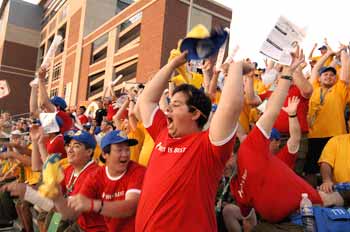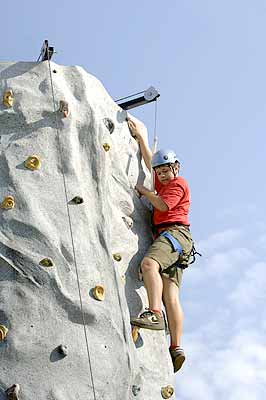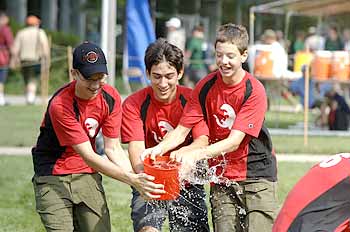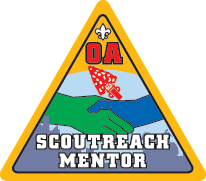Honoring a Legacy of Service
By Jim Lindgren
Photographs by Mary Ann Carter
At the Order of the Arrow's 29th national gathering, members celebrate a rich heritage and plan for even greater efforts of servant leadership.
- Planning NOAC Is a Seven-Month Sprint for Youth Leaders
- It Started at Treasure Island
- Mentoring Program Is Making a Difference
As red and white confetti fluttered onto the floor of Michigan State University's Breslin Center, the national youth leaders of the Order of the Arrow (OA) could breathe sighs of relief and enjoy the raucous scene. Music and the cheers of 8,000 Arrowmen reverberated throughout the arena early last August, celebrating the end of the 2006 National Order of the Arrow Conference (NOAC).
 Shirt slogans and handheld signs say it all for Arrowmen from the BSA's Western Region at their spirited regional gathering. |
Standing arm in arm with the other national OA youth leaders of Scouting's "national honor society," National Vice Chief Chris Schildknecht was flooded with emotions.
"There was relief in that it was over, pride in that we had pulled off an amazing conference, and sadness that it was [completed] and I would never have this opportunity again...," he recalled afterward. "It was the greatest experience of my life so far."
Expanding traditions
Attended by an average of 23 youth and adult representatives from the more than 300 OA lodges in Boy Scout councils across the country, plus hundreds of staff volunteers, NOAC 2006 was the order's largest national gathering. About a thousand Arrowmen attended the first conference in 1948.
For five days starting July 29 and ending Aug. 2, from Saturday's opening theme show to the closing celebration the following Wednesday, the Arrowmen enjoyed sharing fellowship, training, and inspirational events and activities dedicated to expanding the OA's traditions of service and camping promotion. (See "It Started at Treasure Island".)
One of the conference's key sessions, the Leadership Symposium on Monday, examined the meaning and nature of service and the leadership role that is often involved in carrying out that service. The symposium featured a panel of successful leaders from the military, politics, and public service, and at least two Arrowmen from each lodge at the conference attended. The goal was to help participants develop an understanding of how a life is enriched through leadership and service.
Chris Schildknecht began the symposium with a quote about service from John Wesley, the founder of Methodism: "Do all the good you can, by all the means you can, in all the ways you can, in all the places you can, at all the times you can, to all the people you can, as long as ever you can."
That admonition was tied into Scouting by Bradley E. Haddock, chairman of the National OA Committee. He opened his remarks by having the audience recite the Scout Oath and Law. "Those principles are key to understanding who we are," Haddock said, noting that where service is the motivation, leadership opportunities will follow.
"People respect those who are willing to serve," Haddock said. He then urged the assembled Arrowmen to examine their personal commitment to service by asking themselves whether their actions are "self-serving" or dedicated to "serving others."
 John Taylor, Lodge 104, Raleigh, N.C., scales a climbing wall. |
Service opportunities
Arrowmen also had opportunities during NOAC to demonstrate their commitment to service by helping with several projects on the MSU campus.
One involved moving and spreading mulch during a hot afternoon. (Nathan Henkenius, 14, a member of Lodge 66 in the Great Southwest Council, Albuquerque, N.M., said he didn't mind the muggy weather. "I'm good with humidity," he said.)
Another was a food drive, in which Arrowmen filled several trucks with nonperishable items for a local food bank.
One hundred and fifty Arrowmen also helped with Operation Service: Spartan Breakout, a practice evacuation of the fourth floor of the university's football stadium complex, conducted by campus police and the East Lansing Fire Department.
During the drill, Arrowmen helped by portraying victims and evacuees. One "victim," Mike Avery of Lodge 620, Glacier's Edge Council, Madison, Wis., had a special role. He was strapped to something called an Evacu-Trac carrier, so emergency personnel could test the new device, which is designed to move people with limited mobility down a stairway.
Training for everyone
In a wide variety of training courses, Arrowmen learned about topics that ranged from leadership development and event planning to sailing and kayaking to patch design and wilderness first aid.
At a session on running an annual sectional meeting (conclave) of lodges, Tom James, 19, chief of Lodge 21, Crossroads of America Council, Indianapolis, Ind., got tips on how to prepare a budget, raise funds, run registration, and take care of meeting logistics.
"One of my tasks over the next few months is getting ready for our next sectional conclave," Tom explained, noting that he had learned a lot from the session, especially while brainstorming in small groups about creative conclaves. (His group's idea: themed meals, such as a 70's dinner, with participants dressed in retro clothing from the disco era.)
Because of the wide use of American Indian lore, customs, and attire in OA ceremonies, many youth and adult members, through lodge involvement, have become interested in and dedicated to learning more about the history, traditions, and customs of American Indians.
The more than 80 NOAC workshops with American Indian themes offered evidence of this interest. These classes ranged from basic how-to sessions, like "Drum Stick Construction," to cultural studies of American Indians, such as the Iroquois and Seminole, to instruction in the wide variety of tribal dance techniques.
At The Outdoor Adventure Place (TOAP), Arrowmen could visit hands-on displays featuring different camping and outdoor activities. The Experience, an extensive indoor exhibit area, featured a variety of informative display booths, sponsored by manufacturers and organizations.
A chance to compete
There was much more to NOAC than sitting in classrooms and visiting exhibits. During afternoons and evenings, Arrowmen took part in a variety of team and individual indoor and outdoor competitions.
 At the Goodman Games, Derek Patterson, Nick Nowak, and Billy Goehrig, Lodge 76, Mount Holly, N.J., splash through the water-bucket relay while Spencer Pugmire. |
These included a 5-K race; tournaments in Ultimate Frisbee, golf, volleyball, basketball, dodgeball, and several types of card games; wide games like Capture the Flag and a scavenger hunt; and even a pinewood derby.
One of the more unusual contests was the "Pre-School Triathlon," which featured participants hitting a ball off a tee, shooting a tiny basketball at a miniature hoop, and riding a giant rubber ball around an oval course.
Another competitive event involved a NOAC tradition: American Indian dancing and singing, with numerous individual and group categories to enter.
An example of OA member interest and involvement in this activity was provided by Dakota Farley of Lodge 617 in the Buckskin Council, Charleston, W.Va. Attending his first NOAC, the 14-year-old Life Scout entered the Individual Dance Competition. Although he had only about a month to prepare and had to borrow authentic regalia to wear, he enjoyed performing at NOAC, even if he didn't win a prize. "It was an experience!" he marveled.
Along with sports, games, and American Indian dancing, many other types of competition were available to individual Arrowmen and their lodges, including oral history, Web site design, induction ceremonies, patch design, even lodge mascots.
Day of fun
NOAC's final day, known as "Founders Day," is dedicated to fun, starting with a morning parade. National leaders riding in convertibles led the procession around the complex of residence halls at one end of campus. Behind them came representatives of individual lodges, riding in decorated golf carts and waving signs bearing their lodge name. Along the route, Arrowmen scrambled to catch patches and candy tossed by those in the parade.
Later, lodges displayed information and offered samples of regional foods and other specialties in booths set up in an exhibit area. Nearby, Arrowmen were invited to join in the dancing at a classic American Indian pow wow.
The Goodman Games, named after OA founder E. Urner Goodman, featured challenges, such as walking on stilts, making a stretcher and carrying a victim to safety, launching water rockets, and organizing a water-bucket relay.
In that last contest, Mason McCurdy, 17, a member of the volunteer NOAC Service Corps, had the unenviable job of refilling empty relay buckets. Ever upbeat, Mason, a member of Lodge 147 in the Heart of America Council, Kansas City, Mo., saw the task as an opportunity to set an example of cheerful service.
"Volunteering to be a member of the service corps is what I wanted to do at NOAC," he said, "so I'm pretty happy."
That evening, as the closing ceremony ended and confetti collected in bunches on the Breslin Center floor, Arrowmen snacked on ice cream, waiting for an electrical storm outside to pass.
When nature's fireworks moved on, the Arrowmen exited the arena to witness a manmade fireworks display. That spectacular show provided NOAC 2006 with a memorable finale.
Jim Lindgren is a freelance writer and assistant Scoutmaster of Troop 157 in Indianapolis, Ind.
Planning NOAC Is a Seven-Month Sprint for Youth LeadersThe National Order of the Arrow Conference (NOAC) is the BSA's second-largest national event, behind the national jamboree. Unlike a jamboree, however, NOAC traditionally is organized and run primarily by youth—the OA's national, regional, and sectional leaders, plus hundreds of other Arrowmen volunteers. The 2006 national OA youth officers—National Chief Sean Murray, Norwich, N.Y., and National Vice Chief Chris Schildknecht, Cincinnati, Ohio, as well as the new chiefs for each of the four BSA regions—were elected at a national planning conference in December 2005 by 47 OA section chiefs, each representing a group of lodges within a region. The newly elected leaders had little time to celebrate, however, because NOAC 2006 was only seven months away. To help plan the conference, other section chiefs were named to head key committees, such as American Indian Activities, Training, Shows, Special Events, The Outdoor Adventure Place, and others. Those committees then elected conference vice chiefs to help plan specific areas of NOAC. While adult advisers assisted in organizing key conference aspects, such as location, meal service, medical staffing, and registration, the youth organizers understood that it was up to them to provide a memorable conference. "Adult advisers will suggest things, but it ultimately comes down to the conference vice chiefs," explained Chris Schildknecht. While keeping in touch via e-mail and telephone, the committees did not meet in person again until they arrived in East Lansing for the conference. The addition of skateboarding to NOAC 2006 is an example of youth leadership innovation. Advisers ensured that safety would be of primary importance, with participants required to wear pads and helmets, but it was the youth leaders who came up with the idea and made the decision to bring the event to NOAC. Rich Heier, 19, a section secretary from the Northeast Region and a member of Lodge 191 in the Northeastern Pennsylvania Council, Moosic, Pa., served on the Shows Committee. He and the other committee members had to plan four arena shows that would bring the theme "The Legend Lives On" to life. In other words, "We had to deliver that message," Rich said. They decided that each arena show would build on the tradition of cheerful service to others as originally defined by OA founder E. Urner Goodman back in 1915. Their efforts culminated in the spectacular closing show, "Texting Brandon," which featured a young man who resists temptations and repeatedly puts service to others ahead of his own interests. The audience's wildly enthusiastic reception showed how well the committee had truly "delivered the message." —J.L. |
It Started at Treasure IslandRecognized today as Scouting's national honor society, the Order of the Arrow (OA) was founded in 1915 at Treasure Island, the Philadelphia Council (now Cradle of Liberty Council) Scout camp. Camp director E. Urner Goodman and assistant director Carroll A. Edson created a camper's honor society for Scouts who best exemplified the spirit of the Scout Oath and Law in their daily lives. They based this "brotherhood of honor campers" on the legends and traditions of the Delaware (Lenni Lenape) Indians, who in earlier times had used the island as a camping ground. A unique aspect of the original OA program, still unchanged, was that the members were elected by nonmembers, the other Scouts in their troops. Approved as a program experiment in 1922 and as part of the Scouting program in 1934, the OA was eventually recognized, in 1948, as the BSA's national brotherhood of honor campers and an official part of the national camping program. The first National Order of the Arrow Conference (NOAC) was held in 1948 at Indiana University in Bloomington, Ind. OA members will return to the IU campus in 2009 for the 30th NOAC. |
Mentoring Program Is Making a Difference
Michael Kelly, a student at Georgia Tech University in Atlanta, is passing on his camping skills to younger Scouts through the Order of the Arrow's Scoutreach Mentoring Program. "It gives us a chance to do some of the best cheerful service we've done in Scouting," said Michael, 20, an Eagle Scout and member of Lodge 129 in the Atlanta Area Council. OA Scoutreach Mentoring is a partnership between the OA and the BSA's national Scoutreach Division. Its goal is to make Scouting available to all youth, urban and rural, despite their economic circumstances, location, or ethnic background. Many of these urban and rural units do not have experienced leaders or older Scouts with the outdoor skills or experience to provide a quality outdoor program for their Scouts. Under the mentoring program, OA members are paired with troops that need help with developing hiking, camping, and outdoor programs. In Atlanta, Lodge 129 Associate Adviser John Crew says the lodge has been working with OA Scoutreach Mentoring for three years. On events called Scoutreach Activity Weekends at the council's Bert Adams Scout Reservation, Arrowmen, including about 20 Georgia Tech students like Michael Kelly, teach camping, cooking, backpacking, and other outdoor skills to younger Scouts. Many of the boys have never been camping before, Michael said, and their reaction to the training "has been great." He added that he and his fellow mentors always make sure their students have a lot of fun while they are at camp. By the end of the weekend, "It really feels like [the program is] making a difference," Michael said. Lodges interested in participating in the program should contact their local council Scoutreach committee, which can provide a list of units that need help. After mentors have been matched with appropriate units, the mentor and unit leaders will meet to determine how the mentor can help. More information, including an application to serve as a mentor, is available at www.scouting.org/boyscouts/oa/scoutreach. —J.L. |
January - February 2007 Table of Contents
Copyright © 2007 by the Boy Scouts of America. All rights thereunder reserved; anything appearing in Scouting magazine or on its Web site may not be reprinted either wholly or in part without written permission. Because of freedom given authors, opinions may not reflect official concurrence.